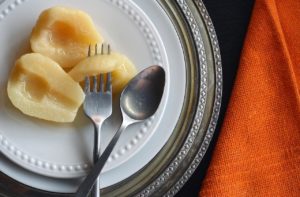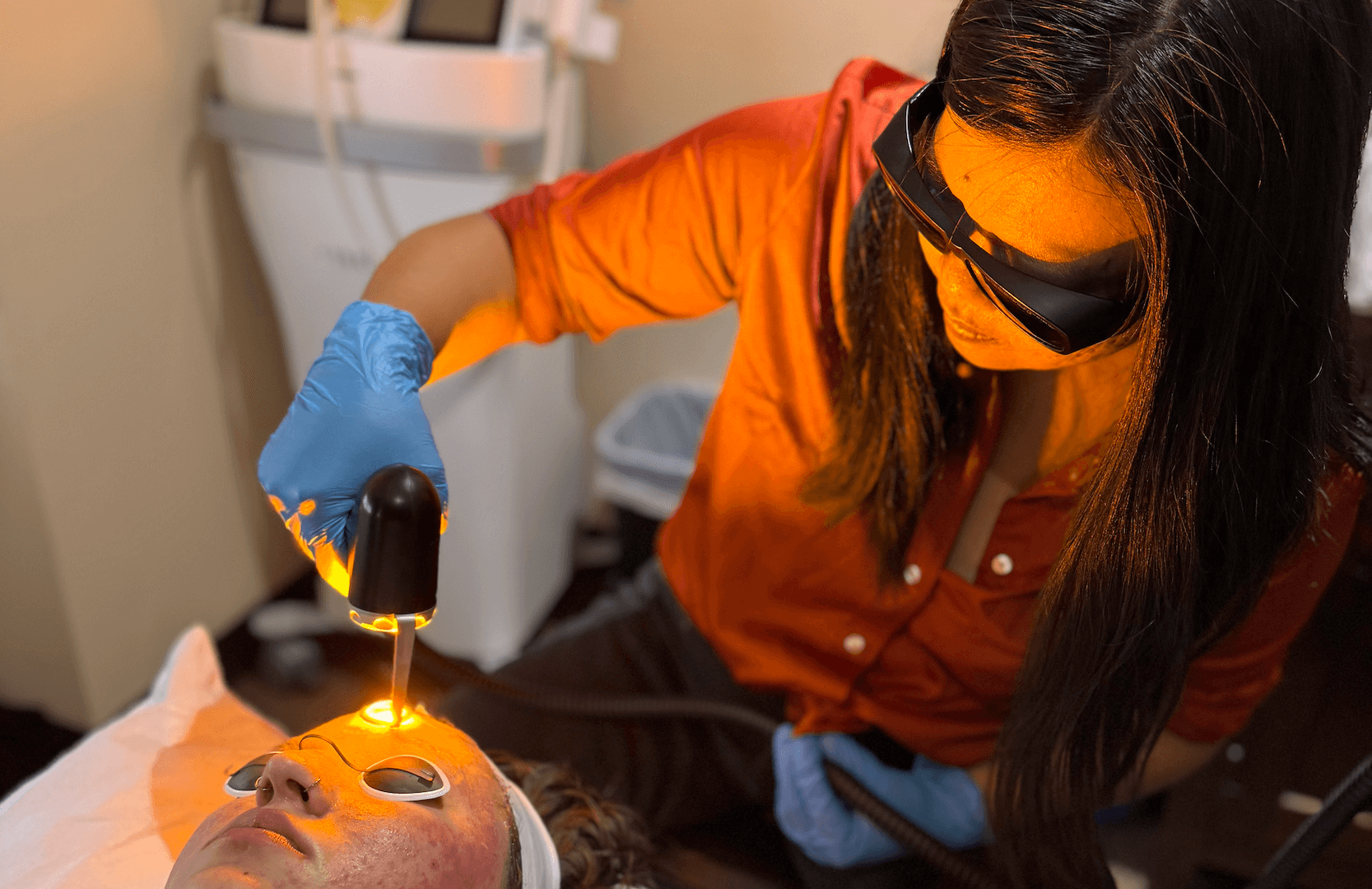ADVATx Laser Integrative Dermatology Open House - June 27th 2024 When: June 27th, 2024 Time:…
Autumn Comforts
Sink into autumn with this delicious Roasted Pear and Honey recipe.
Autumn is a sacred time of year in many cultures. In agricultural cultures that lived in temperate climates like places in ancient China, or in our own Pacific Northwest, It is a time of harvest as well as contemplation; a time to assess what is valuable to us inside and out. What is no longer serving us? Feel the grief and the peace that comes of letting go what we have outgrown. Feel the contentment and gratitude of keeping what is of value. In doing this, we create the space to replenish in the hibernation of winter and rebirth in the new life of spring.
Autumn, Nutrition, and Chinese Medicine
According to Traditional Chinese Medicine, Autumn is associated with the Lung and Large Intestine organs: taking in what is nourishing like oxygen, and purging out what is not useful. In ancient Chinese medicine, nutrition meant much more than “nutrients”. The ancient people also liked to account for the quality, taste, and Qi of the food to determine its benefits for consumption and how it would affect our physiology. This isn’t really that different from our modern culture’s considerations of “organic” vs conventional foods as a way to determine the strength of that food’s Qi. Fundamentally, we understand that food that is grown in more “wild” climates with better soil, and without chemical pesticides will have better “Qi” for our consumption.
The ancient people also believed that certain foods benefited certain organs and meridian systems. For example, Lung and Large Intestine energetically have a close relationship and pears are considered to be optimal food for these organs. Foods like pears and radishes have a porous and moist nature to them that resonates with the structure of the lungs themselves. They’re also foods that are fibrous and hydrating in a way that can support bowel movements.
So, are you ready to nourish body and soul with the offerings of Autumn by making some delicious recipes from what is in season? Squashes, hearty greens, cauliflower, tubers as well as pears and apples are plentiful. Start by trying this delicious Roasted Pear and Honey recipe. Classically, the ancient Chinese Medicine recipe called for roasting Asian Pears with rock sugar in the core. This recipe was often used as therapy during cold and flu season for coughs and sore throats. Here, we’ve modernized it with some pecans, spices, and local organic honey to add some immune optimization. If you’d like to use the food therapy version, simply omit the pecans and spices. Asian pears are THE BEST for lung health. You can use rock sugar, or drizzle manuka honey for immune support.
Food is Therapy
Here are some breakdowns of the nutritional benefits of the foods in this recipe:
Pears
There are thousands of types of pears across the world. In fact, the original Chinese Medicine recipe uses Asian pears which have a crispier juicier texture than the pears we see in America. Consequently, Asian pears are considered the top food therapy for the Lung organ and meridian. Common pears that we see in our grocery stores are Anjou, Bosc, Bartlett, Comice, Seckel, and nowadays, the Asian pear.
In Western nutrition, Pears are significant sources of fiber, vitamin C, vitamin K, potassium1. They contain smaller amounts of calcium, iron, magnesium, riboflavin, vitamin B-6, folate, and copper. Most pears, but especially red-skinned pears contain ample amounts of flavonols, anthocyanins, and carotenoids.
Traditional Chinese Medicine says that pears are cooling, moistening, sweet, and it has a descending direction. According to Chinese medicine theory, the Lungs descend and disperse oxygen out to the rest of the body while the Large Intestine descends our waste. When “heat” occurs, such as upper respiratory illnesses (infection) or constipation (toxicity/inflammation), the cooling properties that pears have can help alleviate discomfort. Pears are considered “moistening” so it lubricates the bowels for smoother transit, and lubricates the lungs during a time when the air is getting drier.
Pecans:
A handful of pecans is all you need to get the health benefits that these delicious nuts have to offer. One serving of pecans is packed with healthy fats, helps lower cholesterol. Additionally, it is a good source of fiber and protein. It also has over a dozen vitamins and minerals including vitamin A and E, calcium, potassium, zinc and many more.
The researchers in this study2 in the European Journal of Clinical Nutrition questioned whether a diet of nuts would raise cholesterol and fat due to their high-fat content. Interestingly, the data suggests that nuts might be protective against obesity, hypercholesterolemia, and insulin resistance.
Honey
High-quality honey, especially local honey, is beneficial for the immune system3. The reasoning for using local honey is that pollination of local flowers helps expose the immune system to these local pollens. This effectively desensitizes the immune system so that it does not overreact to its local natural environment. Another type of mega-immune promoting honey is Manuka Honey which is supposed to be a type of raw wild honey from New Zealand. Local honey makes more sense when considering the “exposure” theory, but the New Zealand honey should theoretically be less adulterated by pollutants, but really, any real honey is a living food.
Cinnamon
Recently, research such as this one4 found in Diabetes Care is aimed at looking at the blood sugar controlling properties of cinnamon. In Chinese Medicine, cinnamon is used to invigorate blood vessels, warm the Yang, and improve digestion.
Let this recipe make your mouth and organs happy on a dry, chilly fall day.
Roasted Pear and Honey Recipe
Ingredients:
2 pears halved and cored
1 Tbsp. butter, ghee or coconut oil, softened
1/4 tsp. cinnamon
1 Tbsp. local honey
1/2 c. crushed nuts *optional
Directions:
Preheat oven to 350 degrees.
Put pears onto baking sheet face up.
Tip: Slice a small sliver of the round end of each pear so it lays flat.
Rub butter, ghee, or coconut oil onto the surface of the pears.
Optional* fill each cored pear with crushed pecans (or other nuts).
Sprinkle with cinnamon.
Put in middle rack in oven for 30-35 minutes or until the surface is golden brown but not burnt.
Bring pears out and let cool for 10 minutes.
Pears should be soft enough to slice with a spoon.
Drizzle honey over as desired.
The best pears for this recipe are Anjou, Bartlett, and Asian pears.
*You can go ala mode to make this dish extra delicious, but keep in mind that ice-cream is often seen as a Chinese medicine nutrition No-No as it is cold and fatty and therefore taxing for the digestive system. But also, small indulgences are healthy.
Resources:
- http://www.whfoods.com/genpage.php?tname=foodspice&dbid=28
- https://www.nature.com/articles/1601802
- Tehereh, E & Moslem, N. Iran J Basic Med Sci. 2013 Jun; 16(6): 731–742. https://www.ncbi.nlm.nih.gov/pmc/articles/PMC3758027/
- http://care.diabetesjournals.org/content/26/12/3215.short





This Post Has 0 Comments